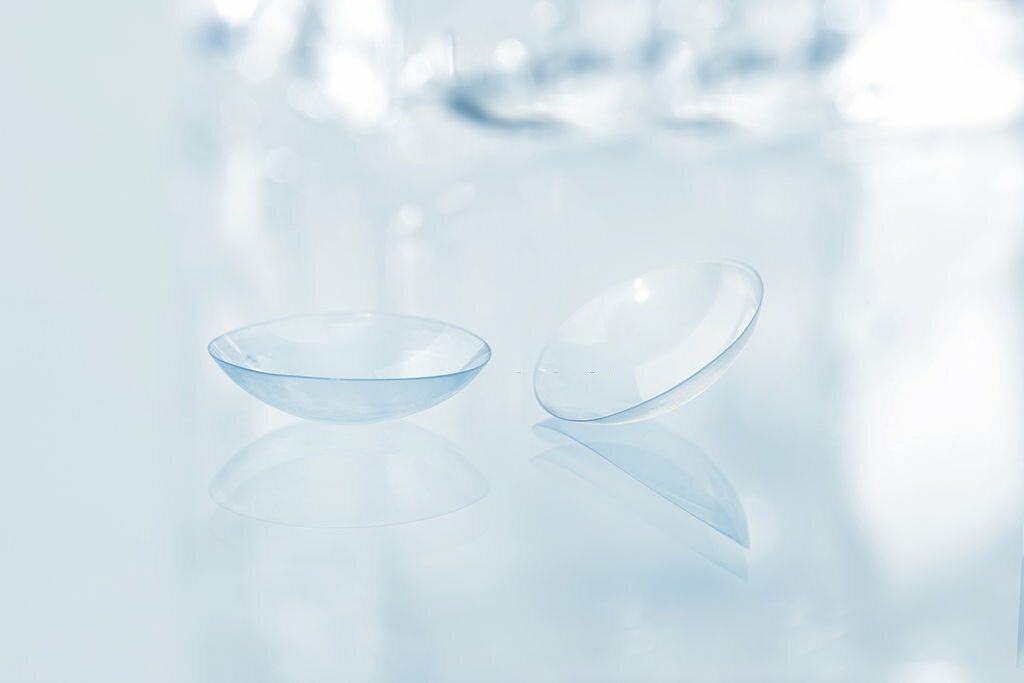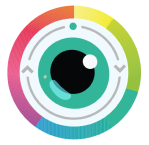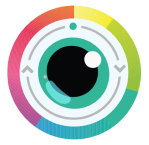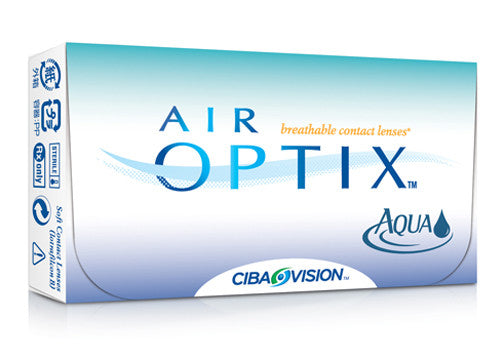
With so many options to choose from, selecting the right types of contact lenses can seem overwhelming. Today, we'll provide a comprehensive overview of the different types available on the market.
Our goal is to educate you about the various categories, materials, and uses of contact lenses, emphasizing their suitability for different vision correction needs and lifestyles.
From soft to rigid gas permeable lenses, lenses designed for specific eye conditions to color contacts, we've got you covered.
Let's dive into the world of contact lenses and discover the best options for you.
What this article covers:Types of Contact Lenses
Understanding the different types of contact lenses is key to making an informed decision about your vision needs. Each type offers unique benefits and is designed to cater to specific preferences.
Let's take a look, shall we?
Soft Contact Lenses
Soft contact lenses are a popular choice for many due to their comfort and versatility. Made from flexible, water-containing materials like silicone hydrogel, they conform to the surface of your eye, offering a natural, comfortable fit.
Their flexibility makes them suitable for a variety of vision corrections and lifestyles, including those who are active or new to contact lenses.
These lenses are available in different replacement schedules, such as daily, weekly, and monthly disposables, to suit various preferences. Their material allows for easy adaptation, making them a preferred choice for those transitioning from glasses to contact lenses.
At Fresh Lens, we offer a variety of soft contact lenses from leading brands like Acuvue. Their lenses are designed for maximum comfort and are ideal for those who experience dry eyes.
With options like 1-DAY ACUVUE MOIST, which offers a fresh pair of lenses each day, employing LACREON Technology to keep the eye moist using ingredients akin to natural tears.
Extended Wear Contact Lenses
Extended wear contact lenses are designed for those who need or prefer to wear their lenses for extended periods, including overnight. What makes these contact lenses special is their improved oxygen permeability.
Our research indicates that these lenses are typically safe to wear continuously for up to six nights and seven days, and some advanced silicone hydrogel lenses can be worn for up to 30 days straight.
Extended wear lenses are particularly beneficial for people with active or unpredictable lifestyles, such as military personnel, outdoor enthusiasts, or shift workers who might not have the time or opportunity to regularly clean and handle their lenses.
At Fresh Lens, we offer a range of extended wear contact lenses to suit these needs. Our selection includes Air Optix Night and Day Aqua, which are designed with high oxygen transmissibility in mind so that you can enjoy the benefits of clear, uninterrupted vision, even with a demanding lifestyle.
Rigid Gas Permeable Contact Lenses
Rigid Gas Permeable (RGP) contact lenses, also known as GP, rigid gas permeable, or oxygen permeable lenses, are durable contacts made of firm plastic that allow oxygen to pass through the lens.
Unlike the old-fashioned hard contact lenses made from polymethyl methacrylate (PMMA), which were oxygen impermeable, RGP lenses are composed of silicone materials that enhance flexibility and oxygen transmission.
This advancement in the material allows oxygen to reach the cornea quicker than most soft contact lenses. Their ability to transport oxygen is comparable to some silicone hydrogel soft lenses. The larger design and closer fit of the lens edge to the eye's surface make them more comfortable and secure.

RGP lenses offer sharp vision and are extremely durable. The materials used in RGP lenses do not contain water, reducing the adherence of proteins and lipids from tears.
These traits mean that RGP lenses can last for years, provided there are no significant changes in the wearer's lens prescription.
Disposable Contact Lenses
Disposable contact lenses offer a hygienic and convenient vision correction solution, with options ranging from daily to monthly replacement schedules.
Daily disposables are discarded each day, while weekly and bi-weekly disposables are replaced every one to two weeks, and monthly disposables are used for a month before being replaced.
Our findings show that the benefit of disposable lenses is that they reduce the risk of eye infections and irritations caused by the build-up of proteins and other substances.
Among the disposable lenses out there, Bausch and Lomb infuse One-Day contact lenses stand out. Made from a silicone hydrogel material called Kalifilcon A, they boast a high water content and superior oxygen permeability, ensuring maximum comfort and breathability.
Note to mention featuring Class 2 UV blocking for added eye protection.
Scleral Contact Lenses
Scleral contact lenses are large-diameter gas-permeable lenses designed to cover the entire corneal surface and rest on the sclera (the "white" of the eye). They are beneficial for individuals who cannot wear regular contact lenses due to irregular corneas or other eye conditions, such as keratoconus.
The space between the cornea and the back surface of a scleral lens acts as a fluid reservoir, which provides comfort for those with severe dry eyes or other conditions that make regular contact lens wear uncomfortable or impossible.

These lenses are significantly larger than standard gas permeable (GP) contacts, with diameters ranging from about 14.5 mm to 24 mm.
There are also different types of scleral lenses, such as mini-scleral lenses (up to 18 mm) and corneo-scleral lenses (approximately 13 to 15 mm), which can be used for conditions that require larger lenses for comfort or to correct irregular astigmatism.
Contact Lenses for Eye Conditions
When it comes to types of corrective lenses, there are specialized options that are designed for specific eye conditions, accommodating vision challenges that standard lenses cannot address.
Single-Vision Contacts
Single-vision contact lenses are designed to correct one type of vision problem: either nearsightedness, farsightedness, or astigmatism.
In contrast to multifocal lenses, these lenses have a uniform power across their entire surface, providing clear vision at either a particular distance or up close.
Among single-vision contact lenses, Clariti 1 Day lenses are an excellent choice available at Fresh Lens. These daily disposable lenses can correct either myopia or hyperopia sightedness, making them an exemplary option for single-vision contacts.
Contact Lenses For Astigmatism
Contact lenses for astigmatism are designed to correct the refractive error caused by an irregular curvature of the cornea. Contrary to the common myth, astigmatism can be corrected with contact lenses, including those more severe cases.
Based on our observations, these lenses come in various types, including daily, monthly, and colored options, catering to different preferences and requirements.
One product that stands out is Total 30 Astigmatism. This lens is specially designed for those with astigmatism and utilizes CELLIGENT™ Technology to resist deposits and bacteria, ensuring a clean lens and a premium wearing experience.
Multifocal Contacts
Multifocal contact lenses are designed to correct presbyopia, a condition that often accompanies aging, resulting in difficulty focusing on close objects.
These lenses combine multiple prescriptions within a single lens, allowing users to see clearly at near, medium, and far distances. They come in various types, such as bifocal, trifocal, and progressive lenses, and are useful for people with more than one refractive error.
The Dailies Total 1 Multifocal, available at Fresh Lens, exemplifies the multifocal lens technology. These lenses feature Water Gradient Technology, creating a cushion of moisture on the eye for exceptional comfort.
Their precision profile design has a smooth progression of power across the lens, ensuring seamless vision at all distances for individuals with presbyopia.
Other Types of Lenses
In addition to corrective lenses, the contact lens market offers colored contacts that enhance or completely change your eye color. Whether you have dark or light eyes, there are a range of options available to suit your needs.
Colored Contacts
Colored contacts are a popular choice for those looking to change or enhance their eye color. These lenses can range from subtle changes to bold new looks.
They are available as both prescription and non-prescription lenses. Prescription-colored contacts change your eye color while also correcting vision problems like myopia, hyperopia, or astigmatism.
Non-prescription colored contacts, also known as Plano contacts, change your eye color only without correcting vision. These are ideal for a Halloween costume or a fun aesthetic change.
Some colored contact lenses are designed to mimic the natural look of the iris, featuring tiny colored dots and radially arranged lines and shapes for a realistic appearance.

They come in different tints like visibility, enhancement, blending, and opaque.
Blending tints offer a natural look by gradually becoming more opaque towards the center, while opaque tints can completely change the eye color, ideal for those with darker eyes or for dramatic effects like costume lenses.
Dark green contacts for brown eyes can provide a natural yet striking transformation, while light blue contacts for brown eyes offer a stunning contrast. For those with blue eyes, colored contacts for blue eyes can intensify or alter the existing shade, adding depth or a completely new hue to your look.
The Air Optix Colors is an excellent choice for those seeking to enhance or change their eye color. Available in 12 different shades, these lenses stand out with their 3-in-1 Color Technology, creating a natural-looking blending effect while meeting correction needs.
Conclusion
In our exploration of the various types of contact lenses, we have highlighted the range of options available to meet different correction requirements. From soft contact lenses known for their comfort to the precision offered by rigid gas permeable lenses, each type presents its unique benefits.
Additionally, the realm of colored contact lenses opens up possibilities for enhancing or completely changing eye color while still keeping vision sharp.
Whether you're seeking colored lenses, condition-specific contacts, or your go-to single-vision lens, our selection is curated to meet your needs.
Shop at Fresh Lens for a clear, comfortable vision experience.
If you want to learn more, why not check out these articles below:
- Best Contacts for Brown Eyes
- Best Natural Contact Lenses
- Colored Contacts for Light Eyes
- Contact Won't Stick to Eye
- How to Put Contacts in Small Eyes
- How to Put in Toric Contact Lenses
- How to Put in Contact Lenses with Eyelash Extensions
- Contact Lens Sticks to My Finger
- What Is Power in Contact Lenses?
- What Are Contact Lens Made of?
- What Are Toric Contact Lenses?
- When Were Coloured Contact Lenses Invented?
- Contact Prescription to Glasses
- How to Read Contact Prescription
- Can You Wear Colored Contacts Over Prescription Contacts



































